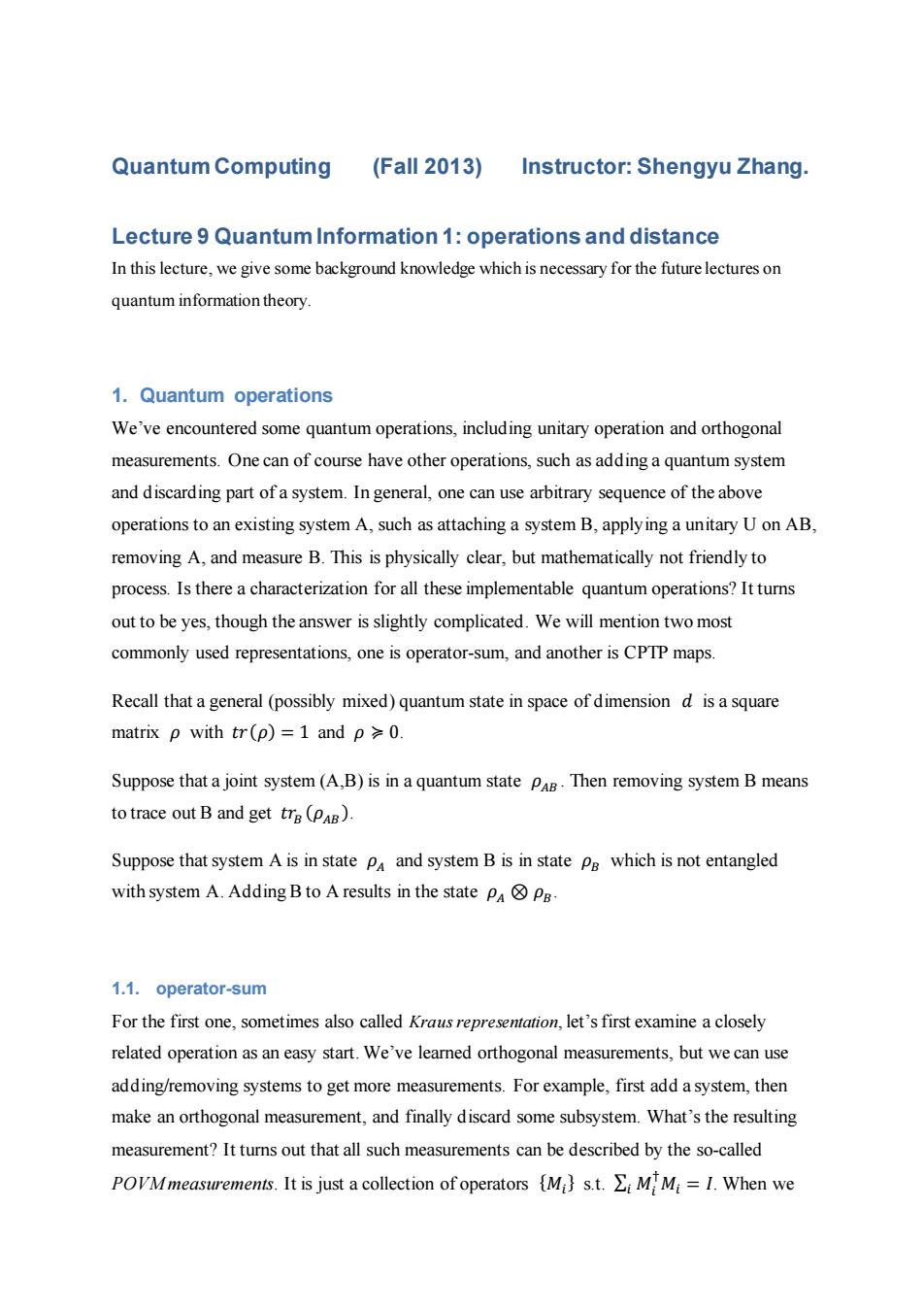正在加载图片...

Quantum Computing (Fall2013) Instructor:Shengyu Zhang. Lecture 9 Quantum Information 1:operations and distance In this lecture,we give some background knowledge which is necessary for the future lectures on quantum information theory. 1.Quantum operations We've encountered some quantum operations,including unitary operation and orthogonal measurements.One can of course have other operations,such as adding a quantum system and discarding part of a system.In general,one can use arbitrary sequence of the above operations to an existing system A,such as attaching a system B,apply ing a unitary U on AB, removing A,and measure B.This is physically clear,but mathematically not friendly to process.Is there a characterization for all these implementable quantum operations?It turns out to be yes,though the answer is slightly complicated.We will mention two most commonly used representations,one is operator-sum,and another is CPTP maps. Recall that a general(possibly mixed)quantum state in space of dimension d is a square matrix p with tr(p)=1 and p0. Suppose that a joint system(A,B)is in a quantum state PAB.Then removing system B means to trace out B and get tra(PAB). Suppose that system A is in state Pa and system B is in state Pg which is not entangled with system A.Adding B to A results in the state PPa. 1.1.operator-sum For the first one,sometimes also called Kraus representation,let's first examine a closely related operation as an easy start.We've learned orthogonal measurements,but we can use adding/removing systems to get more measurements.For example,first add a system,then make an orthogonal measurement,and finally discard some subsystem.What's the resulting measurement?It turns out that all such measurements can be described by the so-called POVMmeasurements.It is just a collection of operators {Mi}s.t.i M;Mi =I.When weQuantum Computing (Fall 2013) Instructor: Shengyu Zhang. Lecture 9 Quantum Information 1: operations and distance In this lecture, we give some background knowledge which is necessary for the future lectures on quantum information theory. 1. Quantum operations We’ve encountered some quantum operations, including unitary operation and orthogonal measurements. One can of course have other operations, such as adding a quantum system and discarding part of a system. In general, one can use arbitrary sequence of the above operations to an existing system A, such as attaching a system B, applying a unitary U on AB, removing A, and measure B. This is physically clear, but mathematically not friendly to process. Is there a characterization for all these implementable quantum operations? It turns out to be yes, though the answer is slightly complicated. We will mention two most commonly used representations, one is operator-sum, and another is CPTP maps. Recall that a general (possibly mixed) quantum state in space of dimension 𝑑 is a square matrix 𝜌 with 𝑡𝑟(𝜌) = 1 and 𝜌 ≽ 0. Suppose that a joint system (A,B) is in a quantum state 𝜌𝐴𝐵 . Then removing system B means to trace out B and get 𝑡𝑟𝐵 (𝜌𝐴𝐵). Suppose that system A is in state 𝜌𝐴 and system B is in state 𝜌𝐵 which is not entangled with system A. Adding B to A results in the state 𝜌𝐴 ⊗ 𝜌𝐵 . 1.1. operator-sum For the first one, sometimes also called Kraus representation, let’s first examine a closely related operation as an easy start. We’ve learned orthogonal measurements, but we can use adding/removing systems to get more measurements. For example, first add a system, then make an orthogonal measurement, and finally discard some subsystem. What’s the resulting measurement? It turns out that all such measurements can be described by the so-called POVM measurements. It is just a collection of operators {𝑀𝑖 } s.t. ∑ 𝑀𝑖 † 𝑖 𝑀𝑖 = 𝐼. When we